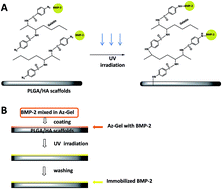Photo-immobilization of bone morphogenic protein 2 on PLGA/HA nanocomposites to enhance the osteogenesis of adipose-derived stem cells
Abstract
Lack of bioactivity has seriously restricted the development of biodegradable implants in bone tissue engineering. In this study, Bone Morphogenic Protein 2 (BMP-2) was photo-immobilized on the poly(lactide-co-glycolide)/hydroxyapatite (PLGA/HA) and pure PLGA composites via photo-reactive gelatin (Az-Gel). The results demonstrate that the Az-Gel facilitates efficient and long-term immobilization of peptides on the surface of PLGA. The immobilization of Az-Gel enhanced the adhesion and proliferation of Mouse Adipose-Derived Stem Cells (ADSCs), while HA incorporation facilitated cellular osteodifferentiation. The immobilization of BMP-2 induced the osteogenesis of the ADSCs, indicated by alkaline phosphatase activity, quantitative real-time polymerase chain reaction (qRT-PCR) analysis and mineralization on the deposited substrates. Furthermore, the surface immobilization of BMP-2 could not only reduce the amount of growth factor, but also have a long-term osteoinductive effect. Therefore, it is considered that the surface modification method has a great potential for the enhancement of osteointegration of biodegradable bone implants.


 Please wait while we load your content...
Please wait while we load your content...